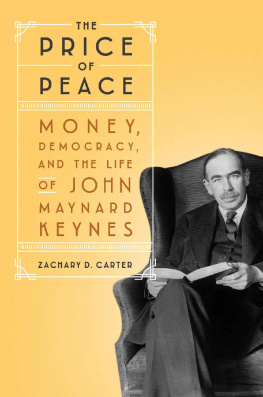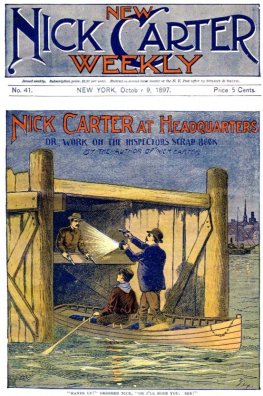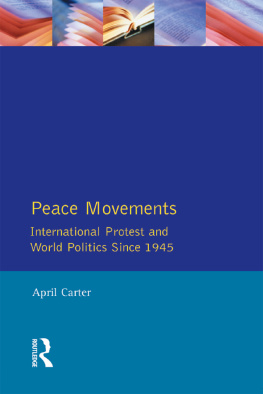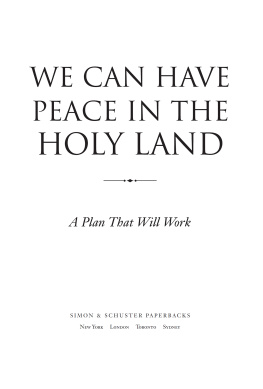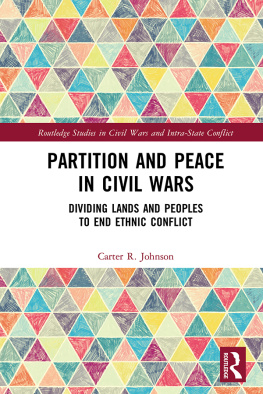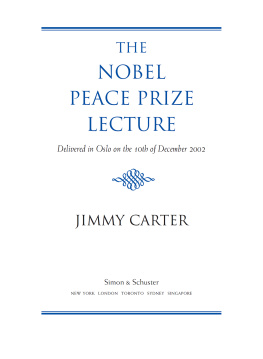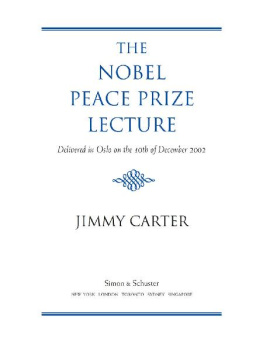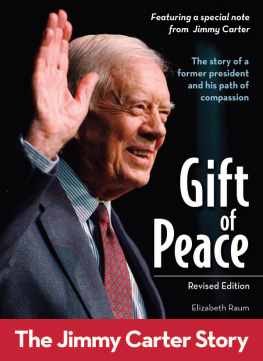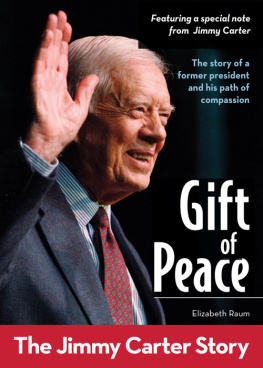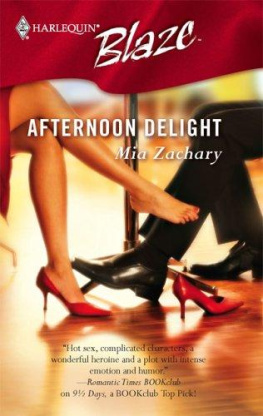Zachary D. Carter - The Price of Peace
Here you can read online Zachary D. Carter - The Price of Peace full text of the book (entire story) in english for free. Download pdf and epub, get meaning, cover and reviews about this ebook. year: 2020, publisher: Random House Publishing Group, genre: Politics. Description of the work, (preface) as well as reviews are available. Best literature library LitArk.com created for fans of good reading and offers a wide selection of genres:
Romance novel
Science fiction
Adventure
Detective
Science
History
Home and family
Prose
Art
Politics
Computer
Non-fiction
Religion
Business
Children
Humor
Choose a favorite category and find really read worthwhile books. Enjoy immersion in the world of imagination, feel the emotions of the characters or learn something new for yourself, make an fascinating discovery.
- Book:The Price of Peace
- Author:
- Publisher:Random House Publishing Group
- Genre:
- Year:2020
- Rating:3 / 5
- Favourites:Add to favourites
- Your mark:
- 60
- 1
- 2
- 3
- 4
- 5
The Price of Peace: summary, description and annotation
We offer to read an annotation, description, summary or preface (depends on what the author of the book "The Price of Peace" wrote himself). If you haven't found the necessary information about the book — write in the comments, we will try to find it.
The Price of Peace — read online for free the complete book (whole text) full work
Below is the text of the book, divided by pages. System saving the place of the last page read, allows you to conveniently read the book "The Price of Peace" online for free, without having to search again every time where you left off. Put a bookmark, and you can go to the page where you finished reading at any time.
Font size:
Interval:
Bookmark:

Copyright 2020 by Zachary D. Carter
All rights reserved.
Published in the United States by Random House, an imprint and division of Penguin Random House LLC, New York.
R ANDOM H OUSE and the H OUSE colophon are registered trademarks of Penguin Random House LLC.
Library of Congress Cataloging-in-Publication Data
Names: Carter, Zachary D., author.
Title: The price of peace : money, democracy, and the life of John Maynard Keynes / Zachary D. Carter.
Description: First edition. | New York : Random House, 2020 | Includes bibliographical references and index.
Identifiers: LCCN 2019037057 (print) | LCCN 2019037058 (ebook) | ISBN 9780525509035 (hardcover) | ISBN 9780525509042 (ebook)
Subjects: LCSH: Keynes, John Maynard, 18831946. | EconomistsGreat BritainBiography. | EconomicsHistory20th century. | Bloomsbury group.
Classification: LCC HB103.K47 .C376 2020 (print) | LCC HB103.K47 (ebook) | DDC 330.15/7092 [B]dc23
LC record available at https://lccn.loc.gov/2019037057
LC ebook record available at https://lccn.loc.gov/2019037058
Ebook ISBN9780525509042
randomhousebooks.com
Book design by Caroline Cunningham, adapted for ebook
Cover design: Lucas Heinrich
Cover photograph: Bettmann/Getty Image
ep_prh_5.5.0_c0_r0
In the long run, we are all dead.
J OHN M AYNARD K EYNES , December 1923
In the long run almost anything is possible.
J OHN M AYNARD K EYNES, April 1942

I N THE SPRING OF 1922, John Maynard Keynes was in love. He was terrified.
Ever since boarding school, Maynard, as his friends called him, had been almost exclusively interested in men. Suddenly at age thirty-eight, he was besotted with a woman nearly a decade his junior: Russian ballet starlet Lydia Lopokova. Im entangleda dreadful businessand barely fit to speak to, he wrote to his friend Lytton Strachey.
To Maynards confidants in Londons cultured enclave of Bloomsbury, the infatuation made no sense. What are we all coming to, pray? Lytton wondered. The Universe totters. He preferred dispassionate, on-again-off-again affairs, like his relationship with the psychologist Sebastian Sprott, whom he was still seeing when he found himself abruptly overwhelmed by Lydia.
Gender and passion accounted for only part of the shock. Maynard was a man of the world. A respected economist and former Treasury official, he had garnered great fame and not a little fortune for the precise clarity of his mind. The august bankers in the City of London and titled aristocrats who followed his work in the financial pages could not believe their ears when they heard that the great Keynes had fallen for, in the words of one earl, a chorus girl. Even Virginias sister, Vanessa Bell, an artist of middle-class stock, was annoyed by the way Lydia chatted up household servants as though they were social equals.
But Lydia dazzled Maynard. Her wit was as nimble as her limbs. He had watched her perform night after night as the Lilac Fairy in the Ballets Russes rendition of Tchaikovskys Sleeping Beauty. He had visited with her backstage, invited her to lunch, stayed out into the small hours of the morning laughing at her jokes, and rented her a flat in the same London square as his ownall within the span of a few short weeks. To Maynard, she was not merely a dancer but an artist, fluent in the high cultural lexicon that linked St. Petersburg, Paris, London, and New York. Though a pending jaunt to India with a British cabinet minister presented him with an opportunity to cool his fevered passions, Maynard found himself unable to break away. He canceled the trip and took Lydia sightseeing around London in a hired car instead. Im in a terribly bad plight, he confessed to Vanessa. She seems to me perfect in every way.
Perfect, but very different. As a child, Lydia had shared a cramped St. Petersburg apartment with four siblings before an audition with an imperial dance academy had rescued her from poverty. Maynard came from a comfortable academic household in Cambridge and made his international reputation working in British government. Is there any resemblance between you and me? Lydia asked. No! So different it becomes attractive. And to Maynard, the enchanting Russian ballerina was more than a talented, talkative artist; she was the living embodiment of an ideal he thought he had lost eight years earlier at the outbreak of the Great War.
Bloomsbury had always been a tiny, insular haven for artists and intellectuals, but paradoxically, it had connected Maynard to a wider, vibrant world beyond London and across oceans. Before the war, Vanessa had visited Pablo Picassos studio in Montparnasse; Maynards friend and sometime lover Duncan Grant had stayed with Gertrude Stein in Paris. Maynard himself had been good friends with the Austrian philosopher Ludwig Wittgenstein, and Bloomsburys art openings, garden parties, and evenings of debate had helped him appreciate other cultural movements whose power transcended language and nationality, from French Postimpressionism to German romanticism and the novels of the Russian pacifist Leo Tolstoy. Through Bloomsbury, Keynes joined an international community of progressive intellectuals who believed themselves to be breaking down the crude medieval barriers between peoples through the power of love and beauty.
The war had shattered that collective illusion. And its fractured, bitter aftermath seemed to show that the golden years of Maynards youth had been little more than the trivial diversions of the British leisure class at the apex of British colonial hegemony. Now, for the first time in years, Lydia offered Maynard hopenot the abstract, probabilistic optimism he typically carried, but a powerful, almost religious hopethat the dream he had lived as a young man could be realized once again. Whatever vendettas Europes leaders might pursue, the wild, impossible love between Lydia and Maynard was proof that the world was filled with beautiful potential. Beneath the ugly, cynical empires of money and politics lay a deeper, more powerful empire of ideas waiting to unite humanity across borders and languages.
The life of John Maynard Keynes was filled with turning points. Few citizens of the twentieth century reinvented themselves with the regularity that Keynes did over the course of his nearly sixty-three years. But the unexpected blossoming of his romance with Lydia Lopokova was the decisive juncture that made him a force in the history of ideas. When Keynes finally did break away from Lydia for a few weeks in April and May of 1922, it was to embark on a new project that, in a turn nearly as surprising as his recent outbreak of love, would establish him as the most important economic thinker of his day.
Keynes was off to the Italian city of Genoa that spring. He did not leave intending to write his first great work of economic theory. He was hoping to make his name as a journalist and perhaps reestablish a place for himself as an adviser to the power brokers of Europe. It was a career experiment born of necessity. Less than three years earlier, Keynes had been exiled from Whitehall and Parliament over the publication of The Economic Consequences of the Peacehis devastating attack on the Treaty of Versailles, the compact which had set the terms of peace at the close of the Great War. His book had exposed the underhanded machinations of Keynes own government at the 1919 peace conference and predicted that the treatys financial arrangements would march Europe to economic ruin, dictatorship, and war.
Font size:
Interval:
Bookmark:
Similar books «The Price of Peace»
Look at similar books to The Price of Peace. We have selected literature similar in name and meaning in the hope of providing readers with more options to find new, interesting, not yet read works.
Discussion, reviews of the book The Price of Peace and just readers' own opinions. Leave your comments, write what you think about the work, its meaning or the main characters. Specify what exactly you liked and what you didn't like, and why you think so.

